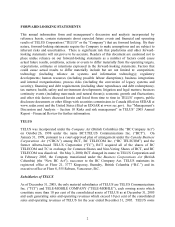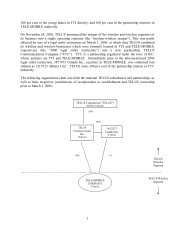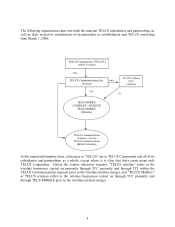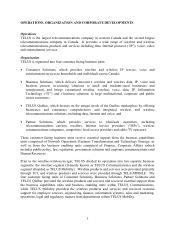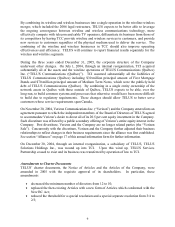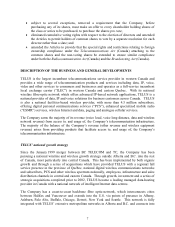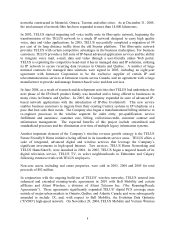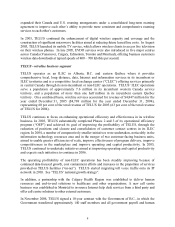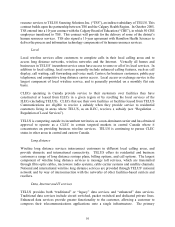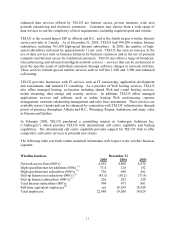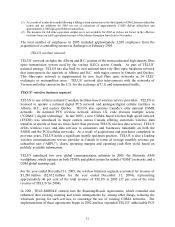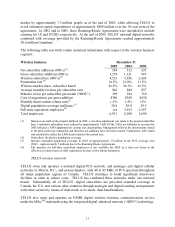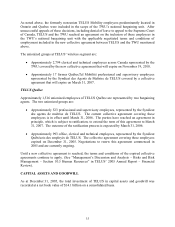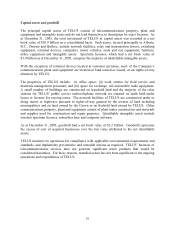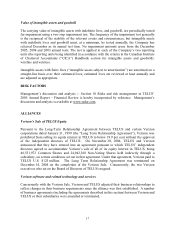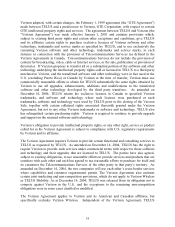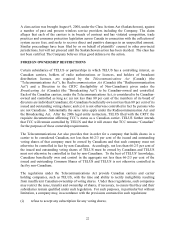Telus 2005 Annual Report Download - page 13
Download and view the complete annual report
Please find page 13 of the 2005 Telus annual report below. You can navigate through the pages in the report by either clicking on the pages listed below, or by using the keyword search tool below to find specific information within the annual report. 12
(1) As a result of a subscriber audit following a billing system conversion in the third quarter of 2002, Internet subscriber
counts and net additions for 2003 are net of reductions of approximately 13,000 dial-up subscribers and
approximately 4,700 high-speed Internet subscribers.
(2) The measure for full-time equivalent employees is not available for 2005 as it does not factor in the effective
overtime hours on staff equivalents because of the labour disruption from July to November.
The total number of employees in 2005 included approximately 3,200 employees from the
acquisition of a controlling interest in Ambergris in February 2005.
TELUS wireline network
TELUS’ network includes the Alberta and B.C. portion of the transcontinental high-density fibre
optic transmission system used by the various ILECs across Canada. As part of TELUS’
national strategy, TELUS has also built its own national inter-city fibre-optic backbone network
that interconnects the network in Alberta and B.C. with major centres in Ontario and Québec.
This fibre-optic network is supplemented by new local fibre optic networks in 34 CLEC
exchanges or metropolitan areas. TELUS’ network also interconnects with the networks of
Verizon and other carriers in the U.S. for the exchange of U.S. and international traffic.
TELUS– wireless business segment
TELUS is one of three national Canadian facilities-based wireless service providers. TELUS is
licensed to operate a national digital PCS network and analogue/digital cellular facilities in
Alberta, B.C., and eastern Québec. TELUS also operates Canada’s only national ESMR
network. Its national PCS wireless network utilizes 1X, code division multiple access
(“CDMA”) digital technology. In late 2005, a new CDMA-based wireless high speed network
(EVDO) was introduced in major centers across Canada offering customers wireless data
transfers at speeds at least six times faster than previous TELUS wireless data services. TELUS
offers wireless voice and data services to consumers and businesses nationally on both the
ESMR and the PCS/cellular networks. As a result of acquisitions and purchases completed in
previous years, TELUS holds a significant mobile spectrum position. TELUS is also a leading
wireless communications service provider in Canada in terms of average monthly revenue per
subscriber unit (“ARPU”), churn, operating margins and operating cash flow yield, based on
publicly available information.
TELUS introduced two new global communications solutions in 2005: the Motorola A840
worldphone, which operates on both CDMA and global system for mobile (“GSM”) networks, and a
GSM global roaming card.
For the year ended December 31, 2005, the wireless business segment accounted for revenue of
$3,296 million ($2,812 million for the year ended December 31, 2004), representing
approximately 40 per cent of the total revenue of TELUS in 2005 (37 per cent of the total
revenue of TELUS for 2004).
In 2001, TELE-MOBILE entered into the Roaming/Resale Agreements, which extended and
enhanced then existing roaming and resale arrangements by, among other things, reducing the
wholesale pricing for such services, to encourage the use of existing CDMA networks. The
implementation of these agreements began in 2002 and has expanded TELUS’ addressable PCS


